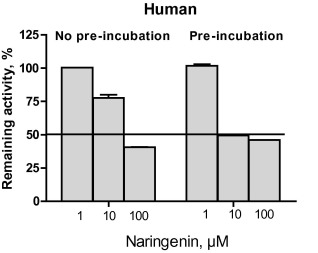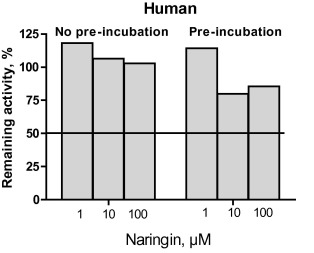Can you provide your sources on that? Here’s what I found from a quick read through the literature:
Furocoumarins are the primary CYP3A4 inhibitors found in grapefruit (Schmiedlin-Ren et al. 1997). The Bergamonte standardized extract of citrus bergamot contains naringin, neohesperidin, neoeriocitrin, melitidin, and brutieridin.
Naringenin inhibited human CYP3A4, while naringin had minimal effect (Burkina et al. 2016).


(Miniscalco et al. 1992) appears to broadly agree, noting that “No inhibition of naringenin was found… until higher concentrations, 300 and 500 [μM], were added.” But the article is old enough that my institutional access can’t crack the paywall. Adding some evidence from a slightly different angle, (Edwards and Bernier 1996) argue that “naringin and naringenin are not the primary CYP3A inhibitors in grapefruit juice”.
(Ho et al. 2001) rounds out the picture: “the inhibition of [human CYP3A4 activity] by bergapten (67%), and quercetin (55%) was greater than naringenin (39%) and naringin (6%), at the same inhibitor concentration of 100 M.”
A quick pass through the literature didn’t yield anything substantial on CYP3A4 inhibition by neoeriocitrin, melitidin, or brutieridin.
I haven’t reviewed the literature on this extensively, but I think it’s important to distinguish the duration of any effect from the duration of a meaningful effect. For example, (Lilja et al. 2000) concludes:
When simvastatin is taken 24 hours after ingestion of “high-dose” grapefruit juice, the effect of grapefruit juice on the AUC of simvastatin is only about 10% of the effect observed during concomitant intake of grapefruit juice and simvastatin.
So, even in the case of a strong CYP3A4 inhibitor, the effect appears to drop off steeply after the first day. Taken together, this collection of data points leaves me with no-to-minimal concern about citrus bergamot and CYP3A4 inhibition. If you have sources that paint a different picture, please share.
Still—if blunted hyperlipidemia is the rationale for combining citrus bergamot with rapamycin, I suspect rosuvastatin would be a better option. We know much more about its mechanism of action. The best option, though, is probably a PCSK9 inhibitor. In C57BL/6 mice, rapamycin increases expression of PCSK9—decreasing hepatic LDLR protein and increasing circulating LDL (Ai et al. 2012). PCSK9-/- mice were unaffected.